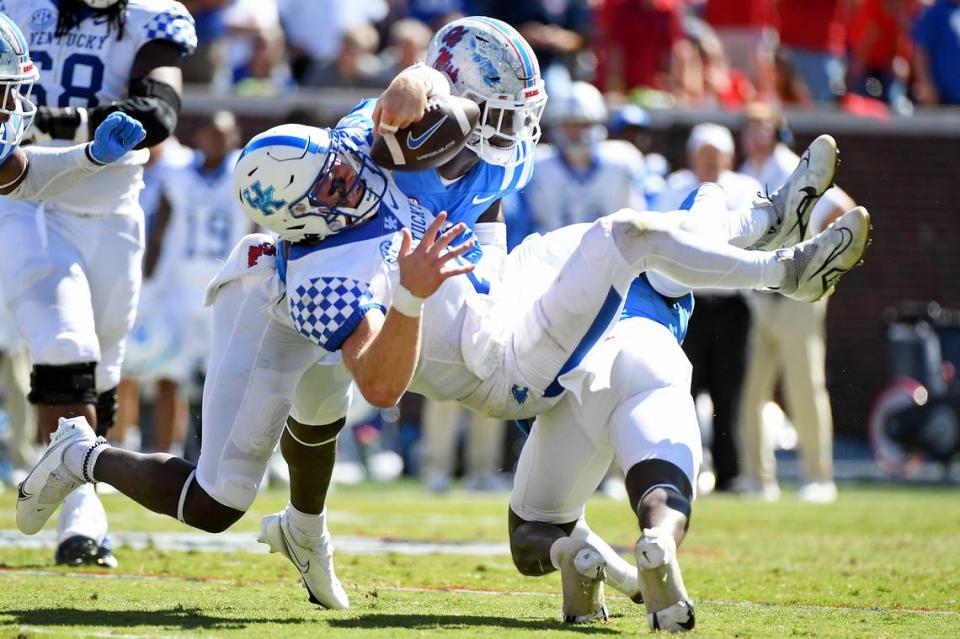What constitutes targeting in college football? Does anyone really know anymore?
- Oops!Something went wrong.Please try again later.
- Oops!Something went wrong.Please try again later.
Never mind MegaMillions or Powerball. If you want to make aspiring zillionaires earn their money against impossible odds, have them answer the following question: What constitutes a targeting penalty in college football?
I don’t know. Do you know? Do the officials know?
“I can’t even answer how to enforce it anymore,” said Mark Stoops on Monday.
For the record, the Kentucky coach wasn’t complaining — at least not publicly — about the controversial lack of a targeting call when his quarterback, Will Levis, fumbled away the football late in Kentucky’s 22-19 loss to the Rebels last Saturday.
Todd Blackledge complained about it. At the time of the fumble, the ESPN analyst remarked on air he thought Ole Miss’s AJ Finley should have been called for targeting for his hit on Levis with 2:55 left.
“Ole Miss has the football, but maybe they shouldn’t,” Blackledge said as the broadcast returned from a commercial break. “As we look at this play again, when Will Levis ran, this should have been a targeting call. Crown of the helmet right on that K of the UK helmet of Will Levis. The next hit caused the fumble, but that should have been a targeting, right Matt?”
ESPN rules analyst Matt Austin, former longtime SEC official, agreed.
“I do,” said Austin on the broadcast. “I think he lowered his head and, as Todd said, he put the front of the helmet right on the UK logo.”
“It’s not defenseless, because (Levis is) running,” continued Blackledge, “but it was the crown of the helmet that led to contact. And Ole Miss was fortunate they got the football.”
Kentucky fans were outraged at the non-call. Oscar Combs, former publisher of the Cats Pause, tweeted, “Whoever is running the SEC press box TV review replay in Oxford should be fired immediately by the SEC for not reviewing the targeting crown to helmet shot of Will Levis. Absolutely no excuse. Absolutely none.”
Whoever is running the SEC press box TV review replay in Oxford should be fired immediately by SEC for not reviewing the targeting crown to helmet shot of Will Levis. Absolutely no excuse. Absolutely none. @SEC
— Oscar Combs (@wildcatnews) October 1, 2022
Here’s how the rule reads: “No player shall target and make forcible contact to the head or neck area of a defenseless opponent with the helmet, forearm, hand, fist, elbow or shoulder. This foul requires that there be at least one indicator of targeting.”
I’m not saying the hit on Levis was or was not targeting. I am saying enforcement of the rule has become so subjective, it’s difficult to know what does constitute a foul and ejection.
Take the UK-Florida game in Gainesville on Sept. 10. On UK’s second drive, Florida’s Justus Boone was flagged for targeting after his solo shot nearly separated Levis from his helmet. After a booth review, however, the targeting call was overturned and Boone was allowed to stay in the game.
“If I had laid their writhing in pain,” half-joked Levis, who jumped right up after the hit, “maybe we would have gotten the call.”
To be sure, the intent of the rule has helped rid the game of the unnecessary hits on defenseless players that produce concussions and injuries. A return to form in tackling skills has contributed to a decrease in targeting calls, from 0.27 per game in 2020 to 0.20 per game in 2021.

It’s the inconsistencies that have made it difficult for fans and coaches to know what is and isn’t acceptable technique.
“It’s very confusing on a national level on what we’re allowed to do as defensive players and what you’re not allowed to do,” Stoops said Monday. “I know as a defensive coach, we are not teaching anything where your eyes are (down) hitting somebody because you’re going to hurt yourself, let alone the player you’re hitting. It could break your neck. I thought we were making progress in getting rid of that, but it doesn’t seem like it anymore.”
What’s the answer? I’m not sure there is a clear one. Officials have a difficult job, enforcing myriad rules in real-time. Crews vary. Some call more targeting fouls than others. Same for replay officials. It all depends on how the rule is interpreted.
The main objective is safety, however. The only way to ensure safety is to correctly enforce tackling rules. For the good of the game, better to have too many targeting calls than too few.
The John Clay Podcast: Reviewing Kentucky football’s tough loss at Ole Miss
Kentucky football’s next big question: How will the Cats react to loss at Ole Miss?
Does Kentucky football have a special teams problem? Numbers suggest it’s not that simple.
UK football’s Vince Marrow defends Will Levis on social media after loss at Ole Miss
No time to mope. UK football’s next five foes have an axe to grind with the Cats.

